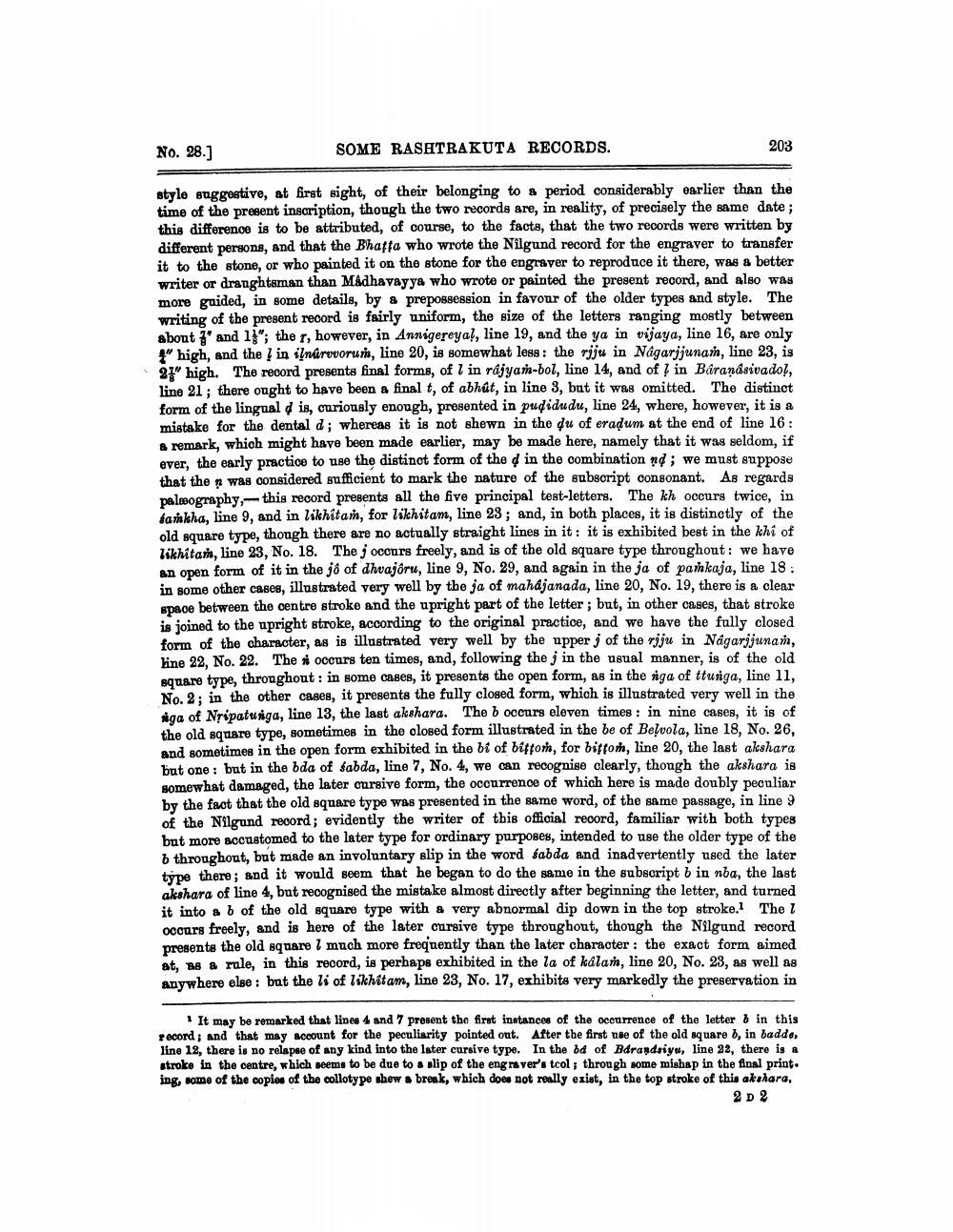________________
No. 28.]
SOME RASHTRAKUTA RECORDS.
203
style suggestive, at first sight, of their belonging to a period considerably earlier than the time of the present inscription, though the two records are, in reality, of precisely the same date; this difference is to be attributed, of course, to the facts, that the two records were written by different persong, and that the Bhafta who wrote the Nilgund record for the engraver to transfer it to the stone, or who painted it on the stone for the engraver to reproduce it there, was a better writer or dranghtaman than Madhavayya who wrote or painted the present record, and also was more guided, in some details, by & prepossession in favour of the older types and style. The writing of the present record is fairly uniform, the size of the letters ranging mostly between about 7' and 1}"; the r, however, in Annigereyal, line 19, and the ya in vijaya, line 16, are only thigh, and the in indruvoruris, line 20, is somewhat less: the rjju in Nagarjjunan, line 23, is 27 high. The record presents final forms, of 1 in rajyan-bol, line 14, and of 1 in Barandsivadol. line 21; there ought to have been a final t, of abhat, in line 3, but it was omitted. The distinct form of the linguald is, curiously enough, presented in pudidudu, line 24, where, however, it is a mistake for the dental d; whereas it is not shewn in the du of eradum at the end of line 16 : & remark, which might have been made earlier, may be made here, namely that it was seldom, if ever, the early practice to use the distinct form of the d in the combination nd; we must suppose that they was considered sufficient to mark the nature of the subscript consonant. As regards palmography,--this record presents all the five principal test-letters. The kh occurs twice, in fankha, line 9, and in likhitan, for likhitam, line 23; and, in both places, it is distinctly of the old square type, though there are no actually straight lines in it: it is exhibited best in the khi of likhitan, line 23, No. 18. The j occurs freely, and is of the old square type throughout: we have an open form of it in the jo of dhuajóru, line 9, No. 29, and again in the ja of pankaja, line 18: in some other cases, illustrated very well by the ja of mahajanada, line 20, No. 19, there is a clear space between the centre stroke and the upright part of the letter ; but, in other cases, that stroke is joined to the upright stroke, according to the original practice, and we have the fully closed form of the character, as is illustrated very well by the upper j of the rjju in Nagarjjunan, line 22, No. 22. The si occurs ten times, and, following the j in the usual manner, is of the old square type, throughout:in some cases, it presents the open form, as in the niga of tturiga, line 11, No. 2; in the other cases, it presents the fully closed form, which is illustrated very well in the Aga of Nripatunga, line 13, the last akshara. The b occurs eleven times : in nine cases, it is of the old square type, sometimes in the closed form illustrated in the be of Belvola, line 18, No. 26, and sometimes in the open form exhibited in the bi of biffon, for bitton, line 20, the last akshara but one: but in the bda of fabda, line 7, No. 4, we can recognise clearly, though the akshara is somewhat damaged, the later cursive form, the occurrence of which here is made doubly peculiar by the fact that the old square type was presented in the same word, of the same passage, in line 9 of the Nilgund record; evidently the writer of this official record, familiar with both types but more accustomed to the later type for ordinary purposes, intended to use the older type of the b throughout, but made an involuntary slip in the word sabda and inadvertently used the later type there, and it would seem that he began to do the same in the subscript b in nba, the last akshara of line 4, but recognised the mistake almost directly after beginning the letter, and turned it into a b of the old square type with a very abnormal dip down in the top stroke. The 1 occurs freely, and is here of the later cursive type throughout, though the Nilgund record presents the old square 1 much more frequently than the later character: the exact form aimed at, 28 a rule, in this record, is perhaps exhibited in the la of kúlan, line 20, No. 23, as well as Anywhere else: but the li of likhitam, line 23, No. 17, exhibits very markedly the preservation in
It may be remarked that lines 4 and 7 present the first instances of the occurrence of the letter 8 in this record, and that may account for the peculiarity pointed out. After the first use of the old square 6, in badde, line 12, there is no relapse of any kind into the later cursive type. In the Od of Bdrandsiyu, line 32, there is a stroke in the centre, which seems to be due to a slip of the engraver's tool; through some mishap in the final print. ing, some of the copies of the collotype shew break, which does not really exist, in the top stroke of this akahara,
2 D2




